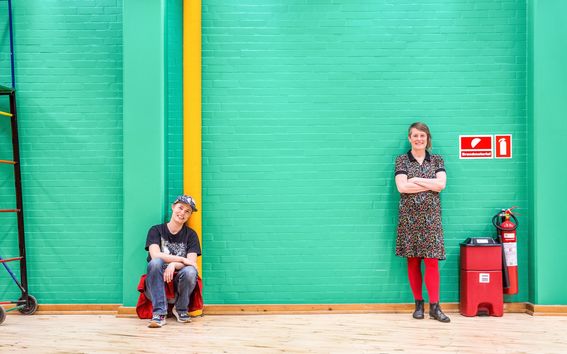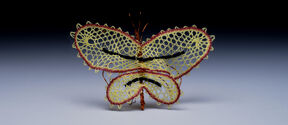Multifunctional Materials Design
Group led by Professor Jaana Vapaavuori

What are e-textiles and smart textiles – and how do they differ?
Jaana Vapaavuori and Anne Louise Bang say the answer depends entirely on who you ask. The professors are behind the NordForsk-funded Beyond E-textiles research project, which brings together researchers from such diverse disciplines that peers have referred to their work as ‘radical interdisciplinarity’.
In practice, the team works on yarns embedded with photoresponsive molecules and nanoparticles, as well as yarns capable of undergoing a shape memory effect. They can be used to create textiles that, for example, convert light into heat or movement.
‘Our work builds on envisioning what could be,’ explains Vapaavuori, who leads the project group from the Department of Chemistry and Materials Science at Aalto University.
‘E-textiles include electronics. We aim to bypass the need for electric circuits,’ adds Bang, professor in design & sustainability at VIA University College in Denmark.
E-textiles often refer to clothing like heated gloves with integrated electronics, while smart textiles are fabrics that react to environmental conditions. But in practice, these terms are often used interchangeably. ‘There’s no consensus in the academic community,’ Bang says.
‘Our research group once had a very heated debate about this during a bus trip. Even close collaborators can wholeheartedly disagree,’ adds Vapaavuori with a laugh.
‘I think it’s alright to use the terms as synonyms. Or simply speak about functional textiles – it’s a good umbrella term for all fabrics that have functions beyond protection and self-expression,’ Vapaavuori says.
Many existing e-textiles have been developed solely from the technological perspective. As a result, they can be challenging to clean and reuse – and their aesthetic appeal is often debatable.
With expertise ranging from chemical engineering to design to fine arts, the researchers are working to create solutions that can weave their way into everyday life to have a major societal impact.
‘We are developing yarns that enable new functionalities – for example in fabrics for curtains, carpets, and wall coverings. These might be useful for regulating indoor temperature. They could cool buildings during the summer and provide more sustainable heating in the winter, for instance,’ Vapaavuori says.
‘There’s also a lot of potential in having new yarns for functional wearables, such as compression socks that can exert pressure in a dynamic and a more precise way,’ she adds. ‘But currently our main contribution is in creating speculative use cases for the new materials. We want to remain open to completely new kinds of applications.’
Bang mentions that the group is also working on static electricity. ‘Jaana’s team – together with computer scientists from the physics department – are creating an algorithm that will enable our team in Denmark to knit fabrics that generate different amounts of static electricity. Then, we’ll try and figure out if we can use the electricity for something more than just producing a crackling or popping noise,’ she says.
‘Most of our work revolves around fabrics powered directly by solar or ambient light or temperature gradients. Our colleagues in Turku are developing self-cleaning cotton using a photo-responsive coating, and we have researchers exploring UV-powered water purification nets. But we also have project members focusing mainly on aesthetics or sustainability, exploring methods such as dyeing and printing fabrics with food waste,’ she adds.
The Beyond E-textilesproject emphasises the importance of working collaboratively instead of exploring issues in silos defined by research and expertise areas. ‘We have project deliverables of course, but we don’t have work packages. We research and develop prototypes in parallel. It helps us learn from each other and encourages innovation,’ Bang says.
‘We don’t wait for Jaana’s group to perfect yarns that react to light and heat before we start weaving fabrics. We use existing smart yarns for prototyping and provide Jaana’s team insights for further refinement. Likewise, our colleagues in Iceland don’t wait for our finished smart fabrics before they start building future scenarios,’ Bang explains.
The researchers from different fields have formed a very tight-knit group, meeting online every other week and face-to-face at least twice a year.
‘You need a lot of trust to work smoothly in such a diverse group. We have it, because Jaana is a very skilled project manager. Our working methods have become something of a gold standard among many of my colleagues. They’ve already suggested adopting them in several other projects,’ Bang says.
‘One of our key takeaways from this project has been understanding how important trust is,’ says Vapaavuori.
There are also many ethical questions that must be taken into account. ‘Consider clothing that monitors your movement, for instance. While it could provide peace of mind in elderly care, it also sparks concerns about data privacy,’ Vapaavuori notes.
‘The same goes for smart textiles for children,’ Bang adds. ‘UV-reactive shirts that alert parents about their toddler’s sun exposure are becoming quite popular. We could develop various types of functional clothing to monitor our offspring – but where do we draw the line on parental surveillance?’
In addition to dealing with ethical questions, the researchers have an essential underlying goal: reduction.
‘Many textiles have a huge impact on the environment. Ultimately, we want to help reduce useless consumption by developing textiles that people get attached to, so they use them as long as possible,’ Vapaavuori says.
Text: Joanna Sinclair
Photo: Michael Damsgaard
This article has been published in the Aalto University Magazine issue 34 (issuu.com), September 2024.
Beyond E-textiles research project



Group led by Professor Jaana Vapaavuori

Interdisciplinary collaboration transforming smart textiles.

Nordic network on smart light-conversion textiles beyond electric circuits

In the future, the innovation could be used in for example the development of smart textiles, soft robotics and medicine.


